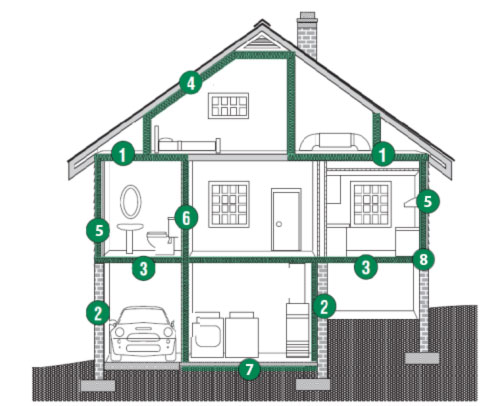Residential Insulation
When building or planning your home, your choices affect its longevity, resale value, performance and your enjoyment. Common requests include removal and replacement of attic insulation, insulating walls in unfinished basements, renovations, sun-rooms, cantilevers, garages, and more. Whether sound proofing a home theatre room, or cold-proofing your basement, we’d be happy to provide a free estimate. No matter what type of insulation you are seeking, we are qualified to do the job efficiently, and we always clean up before it’s time to go home.
Where to use Spray Foam

- Attic space
- Exterior concrete walls
- Bonus room over garage
and heated room over cold crawlspace - Cathedral ceiling
- Exterior wood walls
- Interior wall
- Gravel pad insulation
- Joist space
Solutions
- Thermal Insulation
Polar Foam Soya

- Noise Barrier
Sealection 500 - Fire resistant

Spray Foam vs. fiber insulation
Fiber insulation is a dated technology, and does not perform well outside the laboratory, however it is still used today. If you replace the fiberglass insulation in your home with spray foam, you will save 50% – 80% on your heating bill. Even just one inch of residential spray foam can outperform 6 inches of fiberglass.
Most of a home’s heat-loss (80%) is through convection (air movement). Fiberglass does not stop air movement, but spray foam does. Even if the walls are well sealed there will still be some air convection within the fiberglass. This slow air migration carries heat away from the interior of the wall to the outside (convective looping).
Closed-cell spray foam acts as a building envelope and does not allow any air movement within the wall. With no convection it is much more effective at insulating your home.
Unlike Fiberglass, Cellulose, and Rockwool, Spray Foam Insulation does not lose its insulating properties in real-world situations.
Enviro Home Inc’s foam is applied as a liquid that expands. It gets into every crevice and knot hole. And then hardens to form a continuous air-tight seal. Most heat loss (80%) is by air-infiltration or convection, which is why spray foam performs so well.
Noise Control
Sealection™500 Acoustic Foam
Excluding bad noise and keeping in good sound is why Sealection™500 is a smart and effective way to sound-proof residential and commercial buildings.
A lawn mower, a jet engine, your neighbor’s conversation; can you hear them? With Sealection™ 500 spray foam insulation you won’t. Isn’t that music to your ears?
Noise
People’s perception of noise doubles for every 10dB increase. So it only takes a 10dB reduction to make a room 50% quieter. An additional 10dB reduction will make it seem 75% quieter.
The original STC 30-34 standard used to be enough. Many people are dealing with a noisier environment than they would like. Current research suggests that an STC rating should be at least 50 to get down to a desirable noise level.

